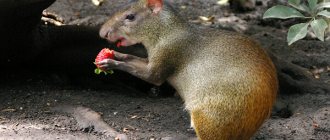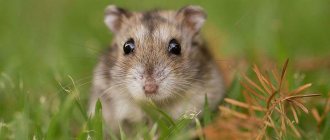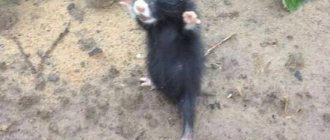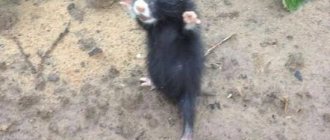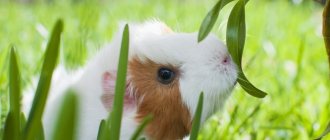Not many owners of domesticated guinea pigs know how their pets' relatives live in the wild. But this information can be useful for more competent organization of keeping these rodents at home. In addition, knowledge about the lifestyle, habitat, nutrition, and reproduction of guinea pigs in the natural environment will help you get a complete picture of these animals.
Structure and appearance
Wild guinea pigs differ in appearance from their domesticated relatives. The body length of the animal varies between 25-35 cm. Weight depends on gender. The average body weight of a female is 800-1200 g, a male is 1000-1500 g.
Features of the exterior of guinea pigs that live in the wild:
- strong bones and elongated, well-built body;
- the short neck is almost invisible;
- an oval small head proportional to the size of the body;
- the muzzle is blunt, the nose is large and wide;
- small ears are located on the head closer to the back of the head and stand straight;
- the eyes are almond-shaped and located far from each other;
- the back is quite wide and straight;
- hind limbs longer than forelimbs;
- paws have 5 toes with claws.
Guinea pigs living in the wild have a coarse coat texture. The color is gray-brown with a reddish tint. Thanks to this coloring, it is easy for the rodent to hide from enemies.
Reference. The fur of guinea pigs not only helps them withstand the cold, but also protects them from extreme heat.
Duration and lifestyle
Wild guinea pigs live about 4-5 years. This is due to the influence of various negative factors, such as disease, malnutrition. Many rodents die early because they become victims of predators. Pets can live 3-4 years longer.
It turns out that wild pigs are very different from domestic ones - they are more resilient, strong, nimble, fast and independent, because they have to constantly fight for life.
Guinea pigs living in the wild are mostly awake at night. During the day they hide in shelters to avoid becoming prey to predatory animals. These rodents rarely dig minks. They prefer to use rock crevices, tree hollows, and abandoned nests of other animals as homes. Some species build something similar to nests in thickets of plants.
Guinea pigs in the wild live in small groups of 10-12 individuals. It is led by the strongest male. He is responsible for the safety of the family and fertilizes the females. As the flock grows, males begin to fight for dominance. Weaker males leave the group.
Each flock of guinea pigs is assigned its own territory, access to which is prohibited to outsiders. Females have different responsibilities - those who have recently given birth take care of the cubs, others look for food.
Guinea pigs make different sounds when communicating with each other:
- rodents warn of danger with a shrill squeak;
- the animals express pleasure by quiet purring and grunting;
- Growling is a sign of aggression.
There are rarely conflicts in the pack (with the exception of the struggle for leadership between males).
In the wild, pigs have to defend themselves from numerous enemies, so they are very careful and timid. In case of danger, rodents can not only run fast, but also swim. They also deftly climb rocky cliffs and tree trunks.
Guinea pigs are also very clean. They spend most of their free time cleaning their fur and grooming themselves. Grooming their fur helps them get rid of their own scent so they can remain undetected by predators.
Attention! In nature, guinea pigs sleep in short intervals - 15 minutes every few hours. Scientists have found that even during sleep, the rodent's brain continues to control its surroundings, and its eyes remain slightly open. This feature helps the animal save its life.
Enemies of guinea pigs in nature
The main danger to kiwis is predators. Among them are birds and other carnivores that live in South America: coyotes, wolves, large Condor and Harpy birds. These rodents have no means of defense, so they can only escape by running or using good camouflage. In order not to stand out from the environment, nature has awarded pigs with a special coat color that allows them to hide against the background of rocks, sand and earth. Fleeing from the enemy, pigs hide in narrow crevices in rocks, small hollows and other secluded places. And so that predators cannot pursue rodents, the latter carefully wash themselves and clean their homes of odor. After all, predators primarily focus on the smell of the prey. Therefore, pigs devote all their free time to water procedures.
The life of wild kavias is full of dangers. But nature has endowed them with sensitive hearing and a sensitive sense of smell. But in addition to instincts, animals have a sufficiently developed mind to take care of the members of their pack, help each other and, thanks to this, provide themselves with a more comfortable existence.
Habitat
South America is considered the birthplace of guinea pigs. Rodents are found in Brazil, Chile, Venezuela, Paraguay, and Bolivia. In Peru and Argentina, these rodents are bred for meat, just like rabbits in Russia. In nature, guinea pigs live in a wide variety of environments, from swampy lowlands to rocky hills.
These rodents prefer to live in temperate climates. The temperature range suitable for them is from +7 to +25 degrees. Guinea pigs easily tolerate short-term heat or cold snaps.
Origin of the name
Translated from Latin, the word Cavia means small pig. The same term exists in the Galibi tribal language (South America). All over the world, the name Guinea pig is better known, but in Russia the prefix “marine” is used. It is believed that this term came to us from the Polish language “swinka morska”, which was once transformed from the German word Meerschweinchen.
It’s not clear where the prefix “Guinean” came from. It is believed that it is a purely nominal epithet, meaning that the animal was brought from distant countries.
Interesting Facts
Some surprising facts will allow you to get to know guinea pigs better:
- Despite their name, rodents do not like water, although in nature they sometimes have to swim across small streams and ponds.
- These rodents eat their own droppings because some of the vitamins in their bodies are absorbed only after passing through the digestive tract again.
- These animals were first domesticated by the ancient Incas about 7,000 years ago.
- The digestive system of guinea pigs is designed in such a way that food moves through the intestines only due to the receipt of a new portion of food. Therefore, animals have to eat very often.
- Rodents' incisors grow throughout their lives. Guinea pigs wear them down when they eat bush branches.
Other care
- Your guinea pig's nails need to be trimmed as they grow.
- It is often not worth bathing an animal. Pigs are clean.
- Long hair is brushed once a week.
- Clean the cage every 4 days and whenever it gets dirty.
- The body must be examined for injuries, cuts and parasites.
Nutritional Features
Guinea pigs in nature eat only plant foods. The animals find places where there is a lot of grass and settle there. Their food is:
- seeds;
- nuts;
- grass – fresh and dry;
- roots and branches of bushes;
- fruits - vegetables, fruits and berries.
If food supplies are exhausted in the selected area, the animals move on. If necessary, they can migrate long distances.
Attention! Rodents get a lot of moisture from succulent food, so they rarely live near bodies of water. The animals are content to drink rainwater or collect drops of morning dew from plant leaves.
Cage requirements
Guinea pigs can be kept in terrariums and aquariums. But the most common home is a cage. The larger the size, the better for the rodent. The cage should be placed in a bright place, but not exposed to direct sunlight.
It is advisable to keep it quiet, but people should be in sight. There should be no tall structures in the cage itself. Any fall is dangerous to health and life.
The bottom must be covered with sawdust or pebbles. You can hang a hammock and a house for shelter.
Reproduction and offspring
Pigs become sexually mature at the age of one and a half months. If at home the owner does not allow the pets to mate so early, then in the wild the mating of a female with a male can occur during the first estrus.
In the wild, guinea pigs breed only in the warm season. During the season, the female gives birth to 2 litters. Pregnancy lasts 67-72 days. In one litter there are from 1 to 8 piglets, the average number is 6. Cubs are born covered with hair, sighted and hearing, their teeth are fully formed.
Guinea pigs already on the second or third day of their life try the food that adults eat, although they continue to feed on their mother's milk. The cubs become completely independent 2 weeks after birth.
Training
The guinea pig is trainable. Different individuals may need additional time to learn.
Most popular tricks:
- respond to a name and come to a call;
- stand on hind legs when required;
- run in a circle for a treat;
- roll the ball and climb over the hoops;
- go to the toilet in the tray.


